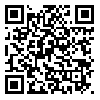Volume 28 - Supplementary
IBJ 2024, 28 - Supplementary: 293-293 |
Back to browse issues page
Download citation:
BibTeX | RIS | EndNote | Medlars | ProCite | Reference Manager | RefWorks
Send citation to:



BibTeX | RIS | EndNote | Medlars | ProCite | Reference Manager | RefWorks
Send citation to:
Darvishi A, Zarimeidani F, Almani N, Keyhani H, Rahmati R, Raeisi Shahraki H. Silent Struggle: Exploring the Mental Health Challenges of Medical University Students. IBJ 2024; 28 :293-293
URL: http://ibj.pasteur.ac.ir/article-1-4728-en.html
URL: http://ibj.pasteur.ac.ir/article-1-4728-en.html
Asma Darvishi 
 , Fatemeh Zarimeidani
, Fatemeh Zarimeidani 
 , Nikoo Almani
, Nikoo Almani 
 , Hossein Keyhani
, Hossein Keyhani 
 , Rahem Rahmati
, Rahem Rahmati 
 , Hadi Raeisi Shahraki *
, Hadi Raeisi Shahraki * 


 , Fatemeh Zarimeidani
, Fatemeh Zarimeidani 
 , Nikoo Almani
, Nikoo Almani 
 , Hossein Keyhani
, Hossein Keyhani 
 , Rahem Rahmati
, Rahem Rahmati 
 , Hadi Raeisi Shahraki *
, Hadi Raeisi Shahraki * 

Abstract:
Introduction: According to several studies, 20-45% of college students encounter at least one mental health condition in any one year, and mental diseases are becoming more prevalent in colleges worldwide. Understanding the relationship between alexithymia and depression, anxiety, and stress among university students can provide valuable insights into mental health challenges faced by this population. Addressing alexithymia with these co-occurring conditions can lead to more effective intervention strategies and support services. This study evaluated the mental health challenges of medical university students.
Methods and Materials: A total of 260 students from the 2019-2020 academic year at Shahrekord University of Medical Sciences were selected using a multi-stage cluster sampling method . To assess alexithymia and depression, stress, and anxiety, standardized questionnaires, specifically the Depression Anxiety Stress Scale-21 and the Toronto Alexithymia Scale, were employed. To compare the scores of depression, stress, and anxiety between students with and without alexithymia, an independent t-test using SPSS 21.0 software was conducted. Additionally, the logistic regression model was utilized to examine the adjusted associations.
Results: Among 260 students, the majority were female (75.7%) and most students aged 20. The study found that male students had a higher mean alexithymia score compared to female students (55.4 ± 12.6 versus 51.6 ± 12.5; p = 0.04), while younger students aged 18-19 exhibited lower mean scores for depression and anxiety compared to older students (4.3 ± 3.2 versus 5.3 ± 3.8 for thosed aged 20; p = 0.04). Similarly, the mean anxiety score was lower in younger students (5.6 ± 4.5 versus 6.9 ± 5.1; p = 0.04). Other demographic factors such as marital status, ethnicity, and residence did not significantly impact these mental health indicators. Pearson correlation analysis revealed significant positive correlations between alexithymia, stress, depression, and anxiety, with depression also being significantly correlated with anxiety and stress and anxiety being significantly correlated with stress.
Conclusion and Discussion: Given the strong correlations between alexithymia and depression, anxiety, and stress, and the potential for exacerbation of each other, it is important to assess students for these disorders. Additional research is necessary for a comprehensive understanding of this topic.

Methods and Materials: A total of 260 students from the 2019-2020 academic year at Shahrekord University of Medical Sciences were selected using a multi-stage cluster sampling method . To assess alexithymia and depression, stress, and anxiety, standardized questionnaires, specifically the Depression Anxiety Stress Scale-21 and the Toronto Alexithymia Scale, were employed. To compare the scores of depression, stress, and anxiety between students with and without alexithymia, an independent t-test using SPSS 21.0 software was conducted. Additionally, the logistic regression model was utilized to examine the adjusted associations.
Results: Among 260 students, the majority were female (75.7%) and most students aged 20. The study found that male students had a higher mean alexithymia score compared to female students (55.4 ± 12.6 versus 51.6 ± 12.5; p = 0.04), while younger students aged 18-19 exhibited lower mean scores for depression and anxiety compared to older students (4.3 ± 3.2 versus 5.3 ± 3.8 for thosed aged 20; p = 0.04). Similarly, the mean anxiety score was lower in younger students (5.6 ± 4.5 versus 6.9 ± 5.1; p = 0.04). Other demographic factors such as marital status, ethnicity, and residence did not significantly impact these mental health indicators. Pearson correlation analysis revealed significant positive correlations between alexithymia, stress, depression, and anxiety, with depression also being significantly correlated with anxiety and stress and anxiety being significantly correlated with stress.
Conclusion and Discussion: Given the strong correlations between alexithymia and depression, anxiety, and stress, and the potential for exacerbation of each other, it is important to assess students for these disorders. Additional research is necessary for a comprehensive understanding of this topic.

| Rights and permissions | |
 |
This work is licensed under a Creative Commons Attribution-NonCommercial 4.0 International License. |





.png)
